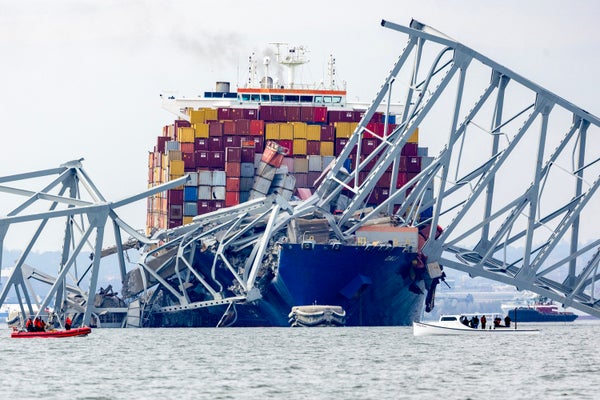Ever Larger Cargo Ships Threaten Bridges, Ports and Other Structures
Cargo ships, like the one that caused the Baltimore bridge to collapse, are getting dangerously big
By Robin Lloyd

The cargo ship Dali sits in the water after running into and collapsing the Francis Scott Key Bridge on March 26, 2024 in Baltimore, Maryland.
Credit:
Tasos Katopodis/Getty Images
Two years ago, a NASA spacecraft successfully crashed into a 160-meter-wide asteroid, altering its course. The first-of-its-kind demonstration showed that humanity has the technology and expertise necessary to deflect Earth-bound space rocks of similar magnitude and prevent them from wiping out a city-sized region. NASA’s Double Asteroid Redirection Test, or DART mission, also might provide fundamental physics insights relevant to the early Tuesday destruction of the Francis Scott Key Bridge in Baltimore, which occurred when a container ship measuring 300 meters in length struck one of the bridge’s support pilings, or piers.
The daunting scale of contemporary container ships relative to many bridges, as well as efforts to divert impacts on infrastructure at ports, can be explained by analogy to the asteroid deflection mission, civil and systems engineer Benjamin J. Schafer of Johns Hopkins University said at a media briefing held on Wednesday. As container ships have grown significantly larger in recent decades to reduce shipping costs and pollution, their size has crept closer to that of bridges and other port structures. Larger ships translate into more potential destruction when things go wrong as well as greater engineering and systems challenges to protect ports from ship strikes and other shipping-related risks.
Barriers called fenders and dolphins are commonly placed in port channels to protect bridges and other infrastructure from ship strikes. Dolphins, depending on their design, can reduce the force of a ship strike on a bridge very little or by as much as 60 percent, says structural engineer Bassem Andrawes of the University of Illinois at Urbana-Champaign. But powerful, sufficiently large ships “can climb over” dolphins, he says, or plow through them. It is not always economically or physically feasible to build barriers large enough to protect port bridges from the biggest ships.
On supporting science journalism
If you’re enjoying this article, consider supporting our award-winning journalism by subscribing. By purchasing a subscription you are helping to ensure the future of impactful stories about the discoveries and ideas shaping our world today.
“There’s just no getting around how large cargo ships are and so how large [redirection and protection systems] would need to be,” said Schafer. That point led Schafer to describe insights from the success of the NASA mission.
The mission showed that diverting the course of large, dangerous objects, such as an asteroid or a massive ship, requires relatively little energy provided that the nudge occurs far enough away from the at-risk object, Schafer said. “So a dolphin or these kinds of bridge protection systems that redirect far away from the bridge can be relatively small,” he said. “But something to stop [a ship] once it’s right at the bridge pier—and you’ve got to take the full energy of that boat—it takes a much more robust system to try to redirect or stop. And in the case of a cargo ship, it might simply be too late in terms of a system that’s right next to the bridge.”
Cargo ships have increased significantly in size in the past few decades as smaller ships have been scrapped or have aged out. In 1956 the first modern container ship carried 58 containers, whereas now the largest of these vessels can carry more than 12,000 containers, says economist and historian Marc Levinson, author of the 2008 book The Box: How the Shipping Container Made the World Smaller and the World Economy Bigger. Today’s largest container ships, called megamaxes, measure 25,000 TEUs (20-foot equivalent units, or the number of 20-foot-long containers that a ship can load). Economies of scale for ever-growing container ships peter out between the high teens and something on the order of 20,000 TEUs, Levinson says.
But midsize container ships such as the Dali, the vessel that struck the Key Bridge, and even larger ones are not going away as long as global population and prosperity grow. In light of this, the Key Bridge’s destruction is leading some experts to call for larger or upgraded fenders around port infrastructure. Some observers noticed an absence of visible fenders and dolphins in the waters near the Key Bridge. But Schafer and other structural engineers have expressed doubts.
“There’s little evidence that it’s economically feasible to create a protection system for a cargo ship that is coming at a full straight-on blow,” Schafer said at the press conference.
Even port bridges with existing fenders and dolphins might suffer damage from a ship strike. Some such barriers have not been upgraded to account for larger ship sizes in decades. At the same time, it is well known that a large portion of contemporary U.S. bridges, which number more than 600,000, are more than 50 years old and undermaintained. And some 7.5 percent of them are considered structurally deficient, says civil and environmental engineer Elias Ali of Case Western Reserve University. In addition to being bigger, today’s cargo ships travel faster than they did 50 years ago, he adds, so they impart even more destructive energy upon impact. “Most critical bridges are not designed and protected to resist a huge impact load from these larger cargo ships,” Ali says.
Megafenders designed to defend against megamax cargo ships would have another undesirable outcome: a drop in channel volume. Instead more effective and affordable solutions include changes to operations, technology and regulations at ports, various experts say. Reducing ship speed limits and extending tugboat escorts could also be studied as potential solutions, Levinson says. Those ideas might not pan out, says Salvatore Mercogliano, a maritime historian at Campbell University and a former merchant mariner. Tugboats typically follow ships in very constrained or dangerous circumstances, and this was not the case in the Key Bridge collapse, which occurred at the Helen Delich Bentley Port of Baltimore. Added tugboat time also would raise the cost of doing business in the port and slow the turnaround time of ships racing to unload, reload and return to sea. And speeds slower than that at which the Dali was traveling before it lost power can make a ship difficult to maneuver, Mercogliano says.
Improved automated early-warning systems, possibly fed movement and other data from sensors placed on vessels, bridges and additional port infrastructure, could speed up alerts and control measures, Ali says. “Remote monitoring and control capabilities allow onshore authorities to intervene in critical situations,” he says. “This could include remotely guiding ships away from bridge piers or issuing warnings to nearby vessels.” Other experts recommend sensors to detect speedy or out-of-control large ships, which would trigger bright flashing lights and sirens to alert bridge operators and traffic.
Other sensor systems at bridge piers could detect potentially destructive ships as they approach. At a certain speed (and thus force) threshold, a hypothetical system could deploy passive or active components as part of a collision-hazard mitigation system, Andrawes says.
He also suggests further research into the use of more deformable or ductile building materials to protect bridge piers from high-energy forces, particularly in earthquake-prone regions. Metallic “shape-memory alloys,” which Andrawes studies, are already used to manufacture biomedical and aerospace components. When these objects are subject to stresses and impacts, they rebound rather than collapse. And such materials are being tested in bridges in Switzerland, Germany, and elsewhere in Europe, he says.
With or without improvements, Mercogliano is confident that ships will continue to grow larger. “The only thing that will stop the growth of ships is if you can’t insure them, and the ports won’t let them in,” he says. Otherwise “they will build them, and they’ll keep coming.”
>>> Read full article>>>
Copyright for syndicated content belongs to the linked Source : Scientific American – https://www.scientificamerican.com/article/ever-larger-cargo-ships-threaten-bridges-ports-and-other-structures/






























